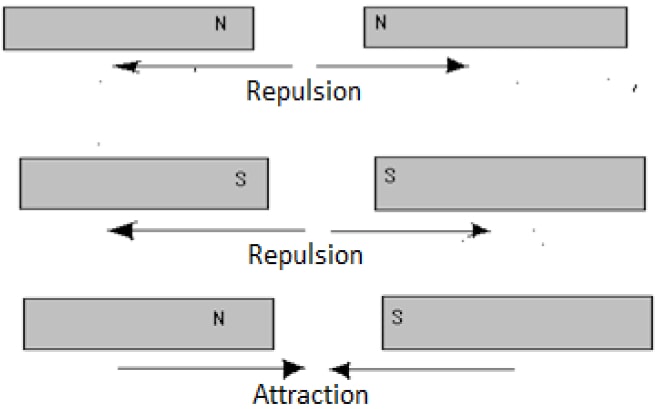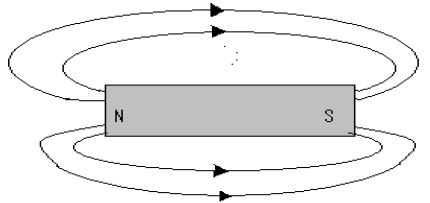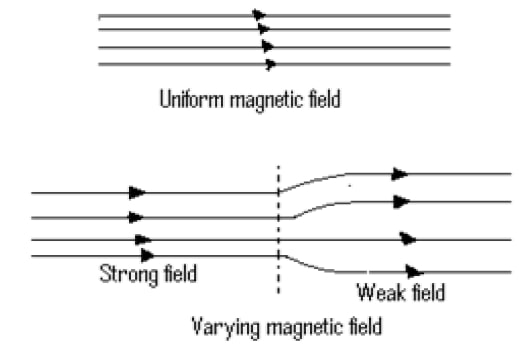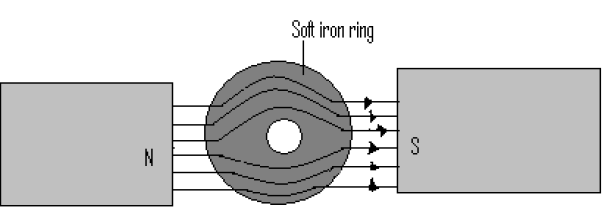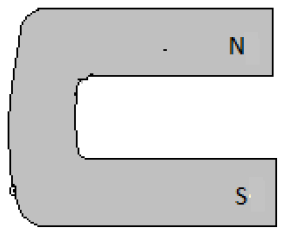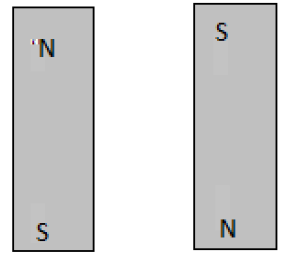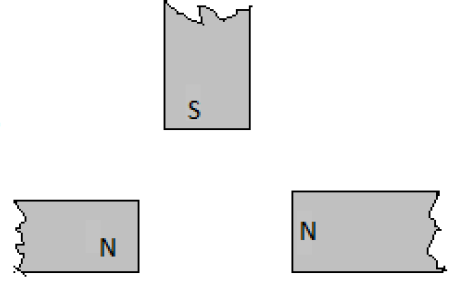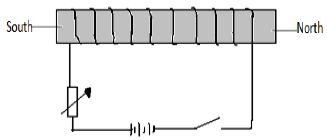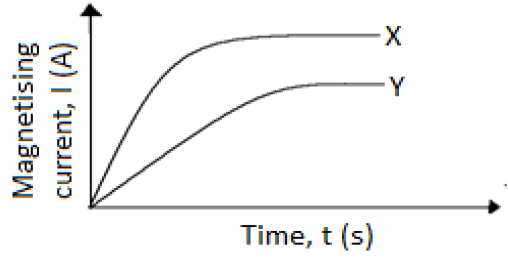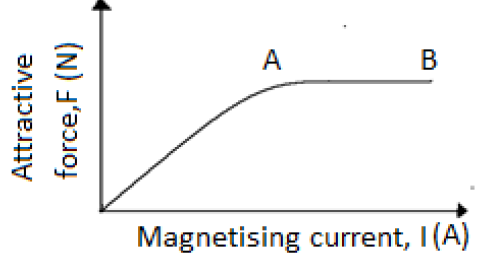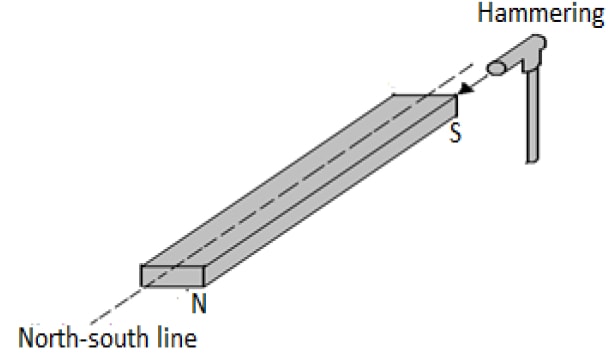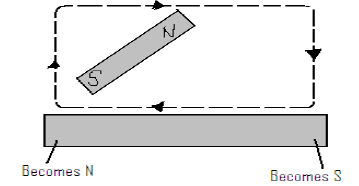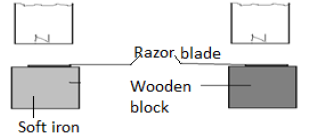- Properties of Magnets
- Magnetic Field Patterns
- The Domain Theory of Magnetism
- Magnetization
- Demagnetization
- Hard and Soft Magnetic Material
- Storing Magnets
- Uses of Magnets
- Revision Questions

Properties of Magnets
- Magnetic poles
- Magnetic poles refer to the ends of a magnet where the power of attraction or repulsion is greatest.
- The force of attraction of a magnet is greatest at its poles.The force reduces away from poles.This is why when a bar magnet is dipped in iron fillings, the fillings cling mainly around the ends of the magnet.

- Directional property of a magnet
- If a magnet is suspended by a thread and is free to rotate it rotates and finally rests in the in the North south direction. This is called the directional property of a magnet.
- Repulsion is the only sure test for polarity of magnet. This is because repulsion can only occur between like poles of magnets. Attraction is not sure test because it can occur between unlike poles of magnets or between a magnet and unmagnetized magnetic material.
- If a magnet is suspended by a thread and is free to rotate it rotates and finally rests in the in the North south direction. This is called the directional property of a magnet.
- Magnetic and non-magnetic materials
- Magnetic materials are those that can be attracted by magnets e.g. Iron, Nickel, Cobalt, Iron alloy like steel, Nickel alloy etc.
- Non-magnetic materials are those that cannot be attracted by a magnet e.g. Copper, Brass, Aluminium, Glass, wood, Graphite
- Ferromagnetic materials are magnetic materials that are strongly attracted by magnet e.g. soft iron
- The Basic Law of Magnetism
- It states that like poles of magnets repel while unlike poles attract.
Exercise
- Describe how you would verify the basic law of magnetism given two bar magnets and a piece of thread.
Solution
Procedure
Suspend one bar magnet. Bring the north pole of another magnet towards the north pole of the suspended magnet and observe what happens.
Bring the same pole towards the south pole of the suspended magnet.
Observations and conclusion
A north pole attracts a south pole and repels a north pole while a south pole repels a south pole. Hence, like poles repel while unlike poles attract.

Magnetic Field Patterns
Magnetic Field
- The space around a magnet where the magnetic influence(magnetic force of attraction and repulsion) is felt.
- The field is stronger near the poles of the magnet and is weaker farther away from the poles.
Magnetic Field Lines
- These are lines of force which represent a magnetic field.These lines form a magnetic field patterns.
Direction of Magnetic Field
- The direction of magnetic field at a point is the direction to which a free north pole would move if placed at that point in the field.
Characteristics/Properties of Magnetic Field Lines
- Magnetic field lines start from the North Pole and end at the South Pole.
- They repel each other sideways and form closed paths as shown above.
- They do not intersect each other.
- They are closer together where the field is stronger.
- Consider two bar magnets with opposite poles adjacent.
- Point x is called neutral point.The resultant magnetic field at the neutral point is zero.
- Magnetic field lines get concentrated along the soft iron.
- The soft iron ring concentrates the magnetic field lines thus preventing them from passing through region P. This is called magnetic shielding and region P is therefore said to be shielded by the ring from magnetic fields.
- Consider two bar magnets with opposite poles adjacent.
Practical Application of Magnetic Shielding
- The soft iron rods and rings are used in magnetic shielding where some electrical measuring instruments and watches are shielded and protected from stray magnetic fields.
Exercise
- Describe how you would shield a magnetic material from a magnetic field. State one application of magnetic shielding.
- Explain the meaning of the following
i. Magnetic field
ii. Magnetic lines of force - The diagram below the magnetic field patterns between two magnets P and Q
- Identify poles A and B
- State which of the two magnet sP and Q is stronger. Explain.
- Sketch the magnetic field patterns for the arrangement below.

The Domain Theory of Magnetism
- Magnets consist of small magnetic groups referred to as magnetic domains. Domains have a common magnetic axis. Domains comprise smaller sub –atomic magnets (molecular magnets) called dipoles. The dipoles in a particular domain point towards a common direction.

Magnetization
- Magnetization is the process of making a magnet from magnetic material. During this process, dipoles get aligned. In a partially magnetized material most but not all domains are aligned in one direction.
- When a material is fully magnetized all the domains are aligned in one direction. At this state the material is said to be magnetically saturated.
- There are four common methods of magnetization; these are:
- Induction
- Stroking
- Hammering in north-south direction
- Electrical method using direct current.
1. Electrical Method
- Direct current is used.
- The magnetic material to be magnetized is placed inside the solenoid connected in series with the battery. The switch is closed and current is passed through the solenoid for sometime.
- The polarities of the magnet depend on the direction of the electric current.
- The poles of the magnet can be identified using the right hand grip rule for current carrying coil which states that: If a coil carrying a current is grasped in the right hand such that the fingers point in the direction of current in the coil, then the thumb points in the direction of North Pole.
Note:
- Allowing the current to flow for along time does not increase the extent of magnetic saturation. It only causes over heating of the solenoid which adversely affects magnetism.
- A solenoid is a coil with many turns of insulated copper wire.
Exercise
- In an experiment to magnetize two substances X and Y using current two curves wave are obtained as shown below.
Explain the difference between X and Y. - The graph in the figure below show the relationship between the attractive force of an electromagnetic and the magnetizing current.
Explain the shape of the curve at point AB using the domain theory.
2. Hammering (Mechanical Method)
- This method makes the use of the earth’s magnetic field. A steel bar to be magnetized is placed in the north-south position and the upper end is hammered. The end pointing northward becomes a north pole and the one pointing southward the South Pole.
3. Induction
- In this method, a magnet induces magnetism in a magnetic material in contact with it. The end of the material in contact with the magnet attains a polarity opposite to the pole of the magnet.
4. Stroking Method
- In this method a magnetic material bar is repeatedly stroked using one end of a strong magnet. Stroking aligns domains and therefore the magnetic material becomes a magnet. There are two types of stroking:
a) Single stroke method
- In this method the magnetic material is stroked with one pole of the magnet from one end to another, lifting it away as shown. The stroking is repeated several times while keeping the inclination of the magnet the same.
- The end of the magnetic material bar where the magnet finishes stroking acquires an opposite polarity to that of the stroking magnet.
Disadvantages of single stroke method
- It produces magnets in which one pole is nearer the end of the magnetized material than the other.
- N/B This disadvantage can be avoided by use of double stroke method.
b)Double stroke method
- In this method, the magnetic material bar is stroked from the centre repeatedly in opposite directions, using opposite polarities of two barmagnets as shown in (a) below or like poles as in (b) below.
Exercise
With the aid of a diagram explain how you would magnetize a steel bar so as to obtain a south pole at marked end of the bar by
- Using a permanent magnet
- Using an electric current
Which of the above method produced a stronger magnet? Give a reason.

Demagnetization
- This is the process by which a magnet looses magnetism. In this process domains reverse their direction and get misaligned (disoriented).
- A magnet can undergo self-demagnetization if poorly stored or the process can be influenced externally by giving the dipoles enough energy to overcome the forces holding them in a particular direction.
- Demagnetization can be hastened by any of the following methods;
- Heating
- Hammering in east-west position
- Dropping on a hard surface
- Electrical method using alternating current.
1. Hammering in East-West Direction
- Hammering a magnet placed in the east-west direction or dropping it on a hard surface floor several times makes it lose most of the magnetism.
2. Heating
- Heating a magnet until red hot and cooling it suddenly when resting in the east-west direction makes it lose its magnetism.
3. Electrical Method
- Placing a magnet in a solenoid placed in east west direction and passing an alternating current demagnetizes it.This is because alternating current reverses many times per second, disorienting the magnetic dipoles.

Hard and Soft Magnetic Material
Soft Magnetic Material
- These are those magnetic materials magnetized easily but do not retain their magnetism for long. Examples:iron, alloy of iron and nickel.
Applications of soft magnetic materials
- Making electro magnets
- Making transformer cores
- Used for magnetic shielding
Hard Magnetic Materials
- These are magnetic materials that are difficult to magnetize but once magnetized they retain their magnetism for a long time. Example–steel.
Application of hard magnetic materials:
- Used in making permanent magnets.

Storing Magnets
- Bar magnets are stored in pairs with soft iron keepers placed across their ends to prevent self demagnetization. Unlike poles of the magnets are placed close to each other.
- The magnets magnetize soft iron keepers through induction.The aligned dipoles form a closed loop or chain round the magnets and the keepers, with no free poles.

Uses of Magnets
- Used in hospitals for removing pieces of iron from the eyes of patients.
- Used in industries as stirrers, lifting iron scrap metals.
- Weather stations for resetting six’s minimum and maximum thermometer.
- Navigation for showing direction as in compass needles
- Magnetic tapes used in audio and video recorders.

Revision Questions
- State the polarities of ends X and Y.
- With the aid of a diagram explain how bar magnets are stored so as to minimize self demagnetization.
- Describe a simple experiment to show the existence of magnetic poles
- Name two properties of a magnet
- What are ferromagnetic materials?
- Using the domain theory of magnetism, explain why
- The strength ofa magnet cannot be measured beyond a certain point.
- The temperature increase weakens or destroys the magnetism of a magnet.
- The graphs below are for two magnetic materials.
- Which material is easier to magnetize?
- Which material forms a stronger magnet?
- State one application of each.
- Why is soft iron used as magnet keeper?
- Describe how you would shield a magnetic material from a magnetic field. State one application of magnetic shielding.
- Use the domain theory to explain a difference between magnetic and non-magnetic materials.
- Two similar razor blades are placed one on a wooden block and the other on a soft iron block as shown below.
It was observed that the razor blade on the wooden block was attracted to the magnet while the other on the soft iron was not. Explain.
Join our whatsapp group for latest updates
Tap Here to Download for 50/-
Get on WhatsApp for 50/-
Download MAGNETISM - Form 2 Physics Notes.
Tap Here to Download for 50/-
Get on WhatsApp for 50/-
Why download?
- ✔ To read offline at any time.
- ✔ To Print at your convenience
- ✔ Share Easily with Friends / Students

